Figure 3.
Hypothetical interaction between PGRN, elastase and SLPI in the CNS. 1) PGRN expression in neurons in the absence of microglial-derived elastase has potentially growth factor and anti-inflammatory properties. 2) In response to CNS injury, microglia are activated and release inflammatory mediators, including proteases. 3) PGRN and elastase levels increase, resulting in the proteolytic cleavage of PGRN into GRNs, which may contribute to the inflammatory milieu. 4) Inflammatory signals such as IL-1β derived from activated microglia cause changes in nearby cells. 5) Astrocytes become reactive in response to inflammatory stimulus from activated microglia. 6) Reactive astrocytes produce SLPI, which along with its other anti-inflammatory properties, inhibits the proteolytic cleavage of PGRN into GRN as a means of feedback regulation of the inflammatory response.

